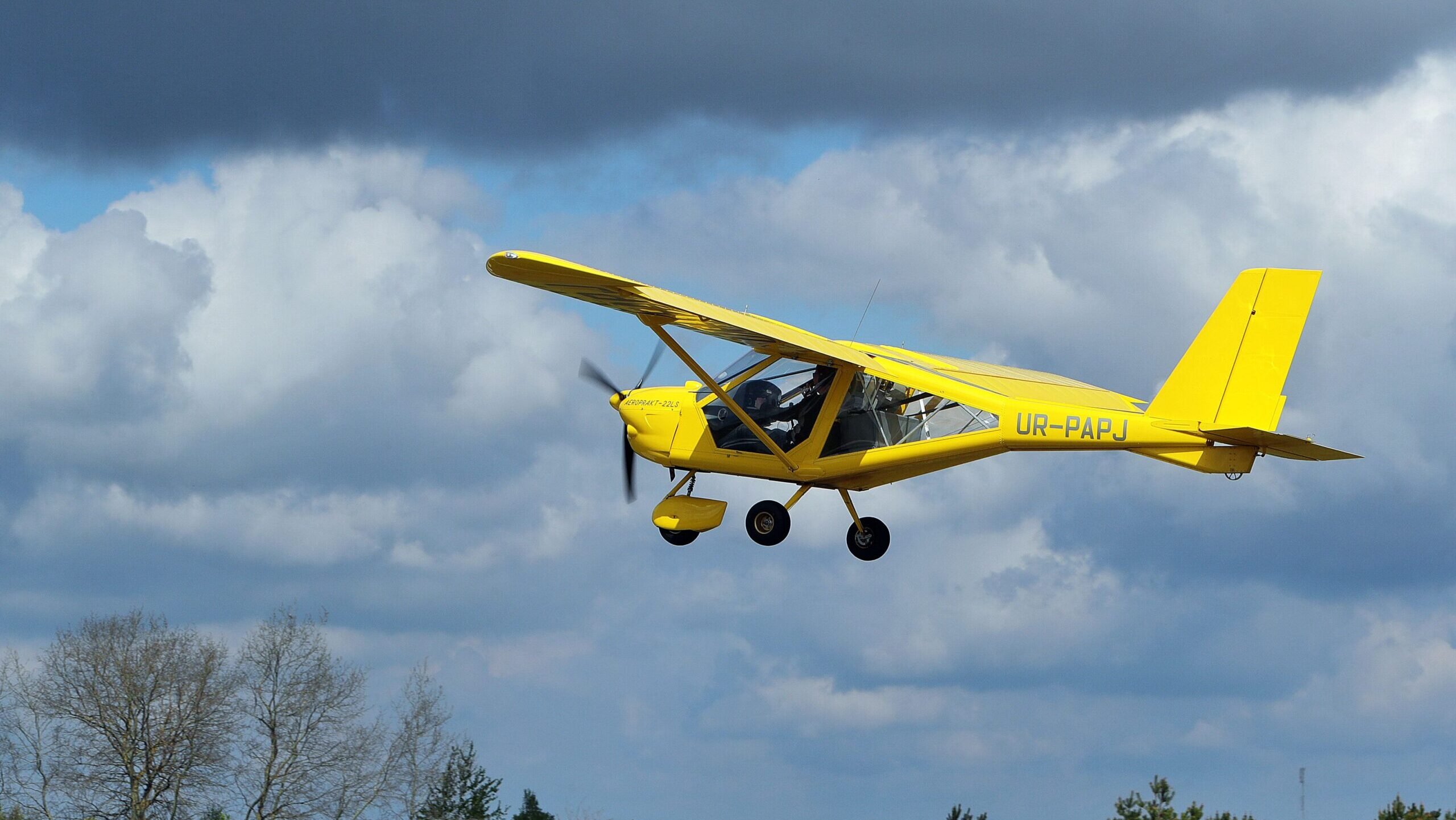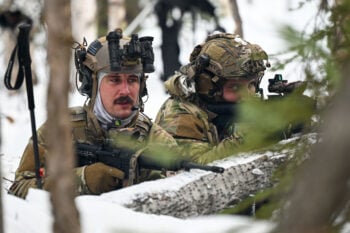
Aeroprakt-22LS plane is pictured during the flight, Nalyvaikivka village, Makarivskyi District, Kyiv Region, central Ukraine, May 4, 2019. Ukrinform. /VVB/ (Photo credit Pavlo Bagmut/Future Publishing via Getty Images)
WASHINGTON — The spate of recent strikes into Russia by Ukraine is showing a heretofore unknown capability for Ukrainian drones — especially the innovative use of the A-22 small civilian plane, which could potentially represent a deep-strike option at a time when Western nations are still reluctant to provide long-range missiles to Kyiv’s aid.
Shortly after the April 2 strikes into the Republic of Tatarstan, multiple local Ukrainian media reported that the attacks were part of a joint operation by branches of the Ukraine Security Service (SBU) and the armed forces’ Main Intelligence Directorate (HUR). Two days after the attacks, Andrii Yusov, spokesman for Ukraine’s HUR, stated that drone strikes such as these carried out on military facilities inside Russia will continue and “their range will increase.”
The two facilities hit were the TANECO oil refinery in the industrial zone of the town of Nizhnekamsk, and the plant recently-built for the series-production of the Iranian-design Shahed-136/Geran-2 drone in neighboring Yelabuga. Both facilities are located more than 1,300 km behind the Russian lines, making these attacks the deepest inside of Russia to date.
Two types of long-range, Ukrainian-made drones were used in these attacks, according to an assessment from the Russian publication Kommersant, considered one of the few reliable media left in country. The smaller of the two appears to be the Ukrjet UJ-22. It has a wingspan of 4.2 meters, is 3.7 meters long and has a maximum speed of 200 km/hour and a payload capacity of up to 20 kg. Material released on the system at a previous AviaSvit, the Ukraine national aerospace and defense expo, specify that ordnance loadings for the system can be free-fall bombs, four 82 mm mortar rounds, or six of PG-7VM rounds normally fired from an RPG-7 launcher.
There were at least two UJ-22s used in these attacks, one of which hit the dormitory that was built to house the student labor force that would be producing the Shahed drones at the Alabuga plant. One of the other UJ-22s struck the TANECO refinery, leaving behind a wrecked portion of the drone. A video of the rear fuselage being recovered was captured on a Russian social media channel. (Some derivatives of the UJ-22 were used on the May 30, 2023 drone attack on the Moscow region.)
But the drone which has attracted the most attention in the aftermath of these attacks is actually the A-22, a small, Ukrainian-designed, hobbyist-grade, ultra-light aircraft made by the firm Aeroprakt. In its standard configuration the A-22 is a two-seat design with a 10.1 meter wingspan and 6.3 meters in length and with a maximum take-off weight of 450 kg.
When the attacks in Tartarstan first occurred, the aircraft was mistakenly identified as possibly being a Cessna design. But while the A-22 has only a slightly smaller wingspan and is shorter than the US aircraft, its maximum take-off weight is less than half of the Cessna 172 models.
There are roughly 900 of these aircraft that have been sold by the company worldwide. Filling it with explosives in place of the normal two-man air crew makes it potentially a high-potential strike weapon. The price is also right: At only $90,000 per plane, the A-22 costs about the same as a single US-made Javelin ATGM.
Why Is The A-22 Potentially Effective Against Russia?
Yuri Mishchenko, director and owner of the Kazan aviation training center “Aviator,” described the A-22 as a “well-made aircraft” to the Russian publication, Business Online, and said that “it’s not for nothing that all of Europe flies the A-22.” It is also not difficult, as he described, to remove the pilot and co-pilot and turn it into a remote-controlled vehicle.
“In our forest patrol version, with two people and special equipment weighing about 50 kilograms, it flies for 6.5 hours, that’s 750 kilometres,” he continued. “If you remove the people and install a 100-liter additional tank, that’s about 700 more kilometres. The unmanned control equipment is unlikely to weigh much—something minimal for level flight. The operating speed is 140 kilometers per hour, the maximum economical speed is 120, and it will be able to fly very smoothly, quietly, and low.”
Russian commentators in the publication Business Online believe that the A-22 was likely under constant remote control via a satellite, possibly through the Starlink system. Using this method also makes it possible for the aircraft to bypass the Russian air defense systems on the ground because “from space you can see where the radars are and which of them are working.” The Business Online commentators cite government sources saying it is possible that the guidance of the A-22 to the targets in the final phases of the flight could have been facilitated by navigation beacons installed in advance of the attack.
It is likely that the Ukrainians will look to repeat the trick with the A-22, as it serves as a relatively cheap, unconventional deep strike threat, according to Valeriy Romanenko, a senior scientific staff member and aviation expert from the Antonov State Museum of Aviation.
Romanenko has been quoted frequently on combat aviation since the war began, since his status within industry and as an aerospace historian puts him outside of the operational chain of command within the Ukraine Armed Forces and gives a voice to those wishing to make a comment but do not want to reveal their role in mission planning.
He spoke to the Ukrainian broadcast outlet Radio NV (New Voice) explaining that “in Ukraine there are more than an adequate quantity of these aircraft and after any decommissioning they can be used as strike weapons. One of its very real advantages is that it can carry a large quantity of explosives but its use in this most recent attack proves that it literally flies ‘under the radar.’”
“This plane managed to fly a distance of 1,200 kilometers virtually undetected. It has a maximum speed of 220 kilometers [per hour], but its normal speed is apparently 160-180 kilometers,” Romanenko was quoted as saying. Russia would have to scramble planes or helicopters to shoot down the plane, had they detected it, he added.
Romanenko also has pointed out that once these aircraft get past the Russian front lines there is no place inside of Russia that they cannot be used to strike at. As he said, “If you fly at low altitude, you can get to virtually any point in Russia without any problems. And if this is a remote target, then [it is easy] as there is no air defence there. Therefore, attacks on oil refineries turn out quite well. … We need to overcome this [Russian] front line, where there is a 60-kilometer electronic warfare zone, continuous electronic interference. And then, as a rule, if you go at low altitude, then, in general, the entirety of Russian territory can be attacked.”
Drone operators are also assisted by another commercial product. Ukrainian drone operators are using a US software program developed in the US by Palantir to map a route to a target that evades Russian air defense emplacements and jamming stations that can disrupt the comm link between the drone and an operator. The estimate is that on any day each side in the conflict has 3000 drones in the air and “the Russians cannot jam them all — or even find them all,” said a Ukrainian EW engineer who spoke to Breaking Defense.
Timing is Everything
The continued successes in using drones to attack Moscow’s military infrastructure continued on April 5 when another Ukraine drone attack struck the Morovosk aerodrome in the Rostov region. The base is home to Sukhoi Su-24, Su-24M modernized variants of the aircraft and Su-34 fighter-bombers. At least six aircraft were destroyed with others damaged and a reported 20 Russian military personnel killed.
Ukraine’s ability to inflict severe damage on Russian military bases, factories, logistical hubs, naval vessels, air defense systems and other high-value targets with drones that are acquired at bargain basement prices may explain Kyiv’s recent lack of enthusiasm about finally receiving their first F-16 fighter aircraft. These will be second-hand airplanes to be transferred from Denmark, Norway and the Netherlands, but the delivery date has moved to the right more than once.
The timing for the F-16s to arrive, which were promised in 2023 but are now not supposed to be delivered until the end of the summer, “won’t be right” for Kyiv’s struggle against the Russian military as Moscow has it constituted today, a Ukrainian officer who spoke to Politico.eu this week said.
“Every weapon has its own right time. F-16s were needed in 2023; they won’t be right for 2024,” this anonymous officer concluded. “Often, we just don’t get the weapons systems at the time we need them … They come when they’re no longer relevant.”
These sentiments are partially due to the frustrations over the nearly two years of back-and-forth discussions about Ukraine being given the aircraft. Ukrainian defense industry firms that spoke to Breaking Defense state that the delays have given Russian time to establish better air defense networks.
“The Russian SAM units so far have had minimum success against drones,” said one Ukrainian industry executive, “but they are far more prepared now to deal with a NATO-standard fighter aircraft like the F-16. In the meantime, we are forced to find ways to adapt US air-launched weapons to the aircraft we have — like the MiG-29.”
“The F-16s are like the modernization of our Buk air defenses by integrating the RIM-7 missile to this platform,” one of the Ukrainian executives in charge of this effort told Breaking Defense. “Aside from the US calling this program a name that everyone now makes fun of,” he said in reference to the modification to the Buk the moniker “FrankenSAM”.
“This program is also going to end up being too little too late,” he lamented. “We needed it yesterday. But here we are now. It’s literally raining Russian missiles, drones and glide bombes and we are running out of missiles for all of our other air defense systems to shoot back with.”
TAI exec claims 20 Turkish KAAN fighters to be delivered in 2028
Temel Kotil, TAI’s general manager, claimed that the domestically-produced Turkish jet will outperform the F-35 Joint Strike Fighter.


























